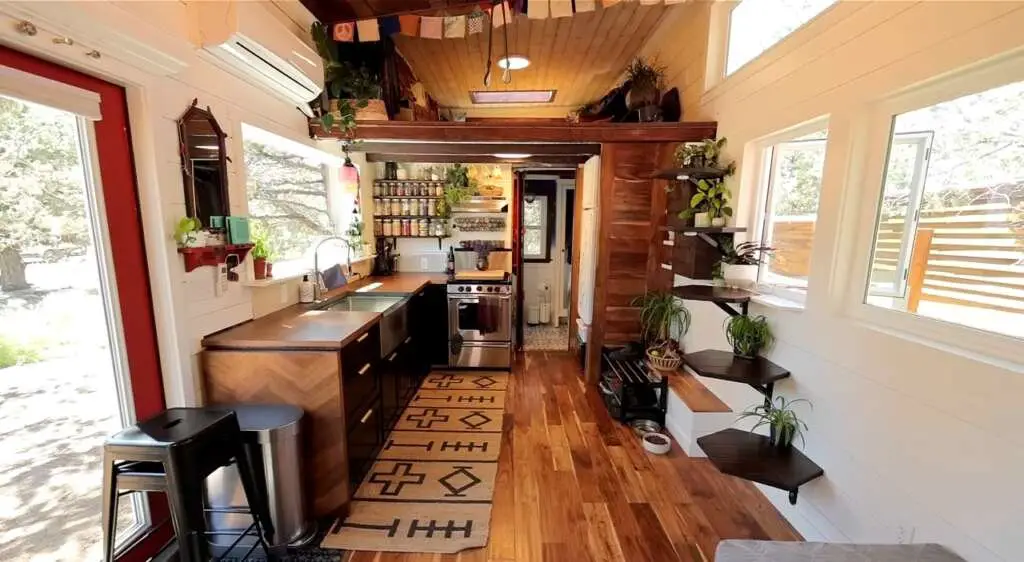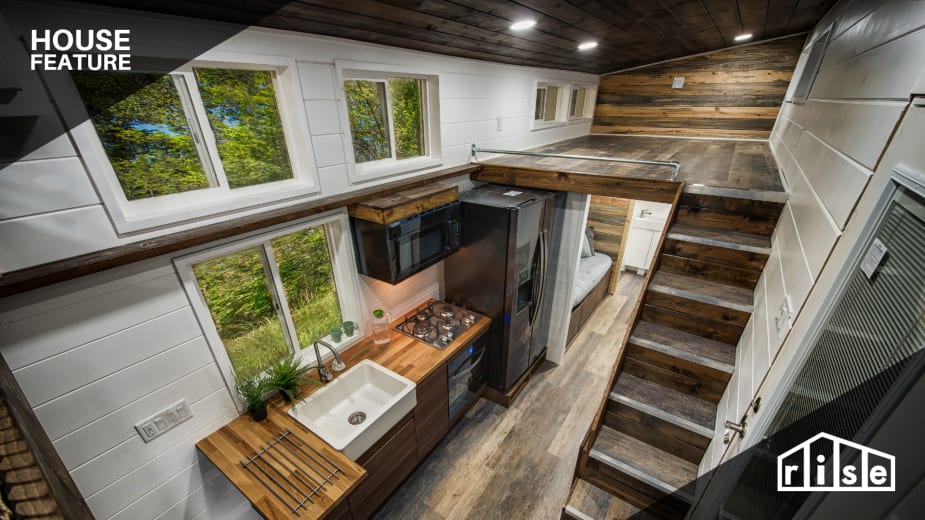Imagine a life without the worries of a mortgage, excessive utility bills, and endless clutter. A tiny home, the latest trend in minimalist living, promises just that. But can a family truly thrive in a space that is smaller than the average master bedroom? In this article, we’ll explore the feasibility of a family living in a tiny home, examining the benefits, challenges, and potential solutions to make this alternative lifestyle a reality. So, grab a cup of coffee and join us as we embark on a journey to discover the world of tiny homes and whether they can truly be a haven for families.
Benefits of Living in a Tiny Home
1.1 Cost-Effective Solution
Living in a tiny home brings numerous financial benefits. The most significant advantage is the lower cost compared to traditional homes. With a smaller living space, the expenses associated with purchasing or renting a home are significantly reduced. Tiny homes also require fewer materials to build and maintain, resulting in lower utility bills. Moreover, living in a tiny home allows you to save money on furniture and other household items since you’ll need fewer of them. By embracing the tiny home lifestyle, you can free up more funds for experiences, travel, or saving for the future.
1.2 Simplified Living
One of the main appeals of tiny homes is the simplified lifestyle they offer. When you have limited space, it encourages you to declutter and only keep what you truly need. This minimalistic approach eliminates the stress and time-consuming nature of maintaining and cleaning a larger home. It also allows you to focus on what truly matters and prioritize experiences and relationships over material possessions. Living in a tiny home helps you appreciate the little things and promotes a more balanced and meaningful life.
1.3 Environmental Friendliness
Tiny homes have a significantly smaller carbon footprint compared to traditional houses. The reduced size means they require fewer materials to build and less energy to heat and cool, resulting in lower energy consumption. Many tiny homes also incorporate sustainable features, such as solar panels, rainwater collection systems, and composting toilets, further minimizing their impact on the environment. So, by choosing a tiny home, you are actively contributing to a greener and more sustainable future.
1.4 Mobility and Versatility
One exciting aspect of tiny homes is their mobility and versatility. Unlike a traditional house, a tiny home can be easily moved to different locations, offering you the opportunity to explore new places or live closer to nature. This mobility also proves advantageous if you have a job that requires frequent relocations. Furthermore, tiny homes can serve as versatile spaces: they can be used as a primary residence, a secondary guest house, a home office, or even a vacation retreat. Their adaptability provides you with the freedom to design a living space that suits your changing needs and aspirations.

Challenges of Living in a Tiny Home
2.1 Limited Space
One of the most obvious challenges of living in a tiny home is the limitation of space. While the minimalist lifestyle can be liberating, it requires meticulous organization and thoughtfulness in terms of what possessions are essential. You may need to downsize significantly and adopt clever storage solutions to make the most out of the available space. However, with careful planning and creative design choices, many people find that the benefits outweigh the initial adjustment to a smaller living area.
2.2 Privacy Concerns
Another challenge to consider is the potential lack of privacy in a tiny home. With family members living in close quarters, it can be challenging to carve out personal spaces or find alone time. Noise, lack of private bedrooms, and shared amenities might pose difficulties, especially if you have teenagers or multiple generations living together. However, by implementing effective communication and establishing clear boundaries within the tiny home, it is possible to maintain privacy and harmony.
2.3 Storage Issues
Due to the limited square footage, storage can be a significant challenge in tiny homes. Finding space for clothing, kitchen supplies, and other household items may require innovative and space-saving solutions. Utilizing vertical storage options like shelving and wall hooks, as well as investing in multi-purpose furniture with built-in storage compartments, can help maximize the available space. Adopting a minimalist mindset and regularly decluttering possessions also play a vital role in keeping storage issues under control.
2.4 Zoning and Legal Restrictions
Living in a tiny home may also present legal challenges, as many areas have specific zoning regulations and building codes that do not accommodate tiny homes. It is essential to research and understand the laws and regulations in your region before committing to the tiny home lifestyle. Additionally, finding suitable land or a community that allows tiny homes can be a daunting task. However, with the increasing popularity of tiny homes, some municipalities are starting to revise regulations and offer more options for those wishing to live in these unique abodes.
Making a Tiny Home Family-Friendly
3.1 Designing for Functionality
When designing a tiny home to accommodate a family, functionality becomes paramount. Every square inch of space should serve a purpose. Open floor plans can create a sense of spaciousness while maintaining efficient use of space. Incorporating multi-functional furniture, such as beds with built-in storage or collapsible dining tables, can help maximize usability and eliminate clutter. It’s also essential to consider the flow and layout of the space to ensure ease of movement and accessibility, especially if accommodating young children or elderly family members.
3.2 Smart Storage Solutions
In a tiny home, the ability to find creative storage solutions becomes crucial. Utilizing under-bed storage, wall-mounted racks and hooks, and vertically stacked shelves can help make the most out of limited space. Installing hidden storage compartments within furniture pieces or utilizing dual-purpose furniture, like ottomans that double as storage units, can also be effective strategies. By thinking vertically, employing innovative storage ideas, and constantly reassessing what items are essential, you can conquer the storage challenges presented by a tiny home.
3.3 Multi-Functional Furniture
Choosing multi-functional furniture is a key consideration when making a tiny home family-friendly. This type of furniture often includes built-in storage, transforms into different configurations, or serves multiple purposes. For example, a sofa bed can provide seating during the day and convert into a comfortable sleeping area at night. Bunk or loft beds can maximize vertical space and accommodate multiple family members without sacrificing floor space. By strategically selecting furniture with versatility in mind, you can optimize your tiny home and adapt to changing family dynamics.
3.4 Considerations for Children
Living in a tiny home with children requires additional thought and planning. Creating designated spaces for children to play and learn is essential. Incorporate features like built-in play areas or study nooks to cater to their needs. Additionally, safety measures become crucial in a confined space, so installing childproof features and considering the layout to minimize hazards is essential. Finally, involving children in the design process can help them embrace the tiny home lifestyle and foster their sense of ownership and responsibility within the space.

Tips for Successful Family Living in a Tiny Home
4.1 Establishing Clear Boundaries
To ensure harmonious family living in a tiny home, it is important to establish clear boundaries. This includes not only physical boundaries but also emotional and personal ones. Communicate openly about each family member’s needs and expectations regarding privacy, personal space, and shared areas. Implementing schedules or designated quiet times can also help maintain a sense of order and minimize conflicts. By proactively addressing potential issues and respecting each other’s needs, you can create a supportive and comfortable home environment.
4.2 Creative Use of Outdoor Space
When living in a tiny home, utilizing outdoor space becomes critical in expanding your living area. Make the most of your surroundings by creating functional outdoor spaces for dining, relaxing, or entertaining. Set up a patio or deck with collapsible furniture that can be easily stored to maximize the usability of the area. Consider incorporating vertical gardening or container gardening to grow your own fresh produce, enhancing the sustainability and self-sufficiency of your tiny home lifestyle.
4.3 Regular Decluttering and Organization
In a tiny home, clutter can quickly accumulate and overwhelm the limited space. Regular decluttering and organization are essential to maintain a tidy and functional living environment. Implementing a system for organizing belongings, such as assigning specific areas or using labeled storage bins, can help keep items organized and easily accessible. Encourage the whole family to participate in decluttering sessions and adopt a minimalist mindset to prevent unnecessary accumulation of belongings.
4.4 Keeping an Open Mind
Living in a tiny home requires adaptability and a willingness to embrace change. It’s important to approach life in a tiny home with an open mind and a positive attitude. Embrace the simplicity and freedom that comes with downsizing and prioritize experiences and relationships over material possessions. Be open to creative solutions, unique design ideas, and unconventional ways of living. By maintaining an open mind, you’ll be able to fully enjoy the benefits of tiny home living and create lasting memories with your family.

Real-Life Examples of Families Living in Tiny Homes
5.1 The Adams Family: A Family of Four in a 400-Square-Foot Tiny Home
The Adams family embarked on their tiny home journey to achieve financial freedom and a simpler lifestyle. Their 400-square-foot tiny home is efficiently designed with a loft for their two children and multi-functional furniture that maximizes space. They have embraced the close-knit living environment and found that it promotes better family bonds and communication. The Adams family demonstrates that with careful planning, organization, and a positive mindset, even a family of four can thrive in a tiny home.
5.2 The Anderson Family: Living a Minimalist Lifestyle with Children
The Anderson family’s decision to live in a tiny home with their children was driven by their desire to simplify their lives and reduce their ecological footprint. Their small home is carefully designed with built-in storage and multi-functional furniture to accommodate their family’s needs. They have instilled in their children the values of minimalism, conscious consumption, and appreciating experiences over material possessions. The Anderson family serves as an inspiration to others seeking a minimalist lifestyle without sacrificing the happiness and wellbeing of their children.
5.3 The Johnsons: A Family on the Move with a Texas-sized Tiny Home
The Johnsons embarked on a unique adventure when they decided to live in a Texas-sized tiny home while traveling across the country. With a custom-built tiny home on wheels, they have the freedom to explore new places and provide their children with a unique educational experience. Their tiny home incorporates smart storage solutions and flexible living spaces to accommodate their family’s needs on the road. The Johnsons prove that a tiny home lifestyle doesn’t have to limit your horizons – it can actually open up a world of possibilities for family adventures and personal growth.
In conclusion, while living in a tiny home with a family presents its challenges, the benefits far outweigh them. The cost-effectiveness, simplified living, environmental friendliness, and mobility offered by tiny homes make them an attractive option for families seeking a more intentional and balanced lifestyle. By carefully considering design, storage solutions, and the unique needs of each family member, it is possible to create a family-friendly tiny home that fosters togetherness, creativity, and a sense of adventure. So, if you’re willing to embrace a smaller space and a simpler way of life, a tiny home could be the perfect choice for you and your family.



